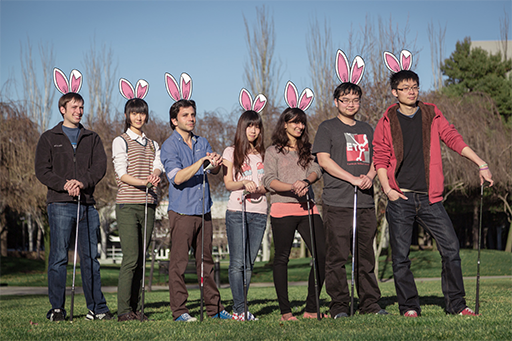February 25 – 28, 2014
Where we spent last week planning, this week we put plans into action, running our first playtests, building our first level, implementing an original user interface, and revising everything.
We started the week with a playtest of a prototype level we had shown at softs. We hadn’t designed this to be a real first level, but a vertical slice that would help us understand our process. Actually putting this in front of players—two fellow students and one faculty member—helped us understand the game itself.
We saw the difference in play styles between players familiar with golf and golf games, and more naive players. We saw our course took almost three times as long as we had hoped. We also saw players smile when they figured out how to get a ball into a hole using the quirks of our “golf meets MC Escher” design. We heard players hold their breaths as they tapped their ball off of one island, hoping it would land on an island below and not roll into the abyss that surrounded it. For us, these moments verified that while we had a lot to fix, we had something like a good idea.
A mid-week meeting with our client enforced these themes. If naive players were confused by having to choose from seven types of shots twenty five types of clubs, reduce this decision making. Focus, they reminded us, on the few things that were exciting and new. Think about what it means to be good at this kind of game and build the game and its puzzles around this.
We did just this as we built and revised our first true level. Our course became simpler and shorter, easier to play quickly. Each of the three holes taught just one idea. We reduced the number of decisions a player needed to make, combining the idea of short types and club selection to have just one club for each of six shot types. At the same time, we focused on fixing some of the bugs and quirks that lengthened our playtimes.
If we were going to combine hit type and club type function to players, we needed a way to visually communicate this. Our UI/UX artist built two icon mock ups. One used the existing visual metaphor of simple lines to show the angle a ball would take when first hit. Another more complex icon represented the full path a ball would take if hit with full power. We tested these, showing testers both icons (alternating which they saw first) and asking them to draw the path they thought the ball would take. Illustrations for the first were erratic, we found, while illustrations for the second were consistent, if not accurate.
As we move into the second week of our planned two-week production cycle for each level, we’ll internally playtest a rough version of our first level for gameplay as we finalize the art. We’ll implement a simplified user interface that helps players better predict where their ball will go. At the same time, we’ll begin sketches for our second level, which is schedule to go into production the week after next.
